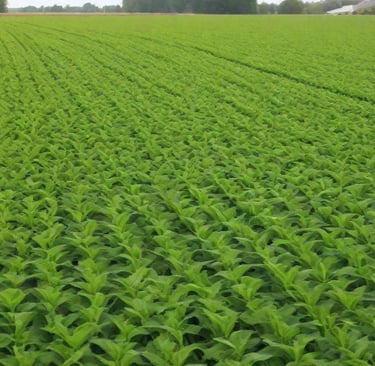Top 10 Ground Cover Fodder Crops for Sustainable Farming: Boost Soil Health & Livestock Nutrition
Discover the best ground cover fodder crops for sustainable farming with our expert guide. Learn about the top 10 options including clover, alfalfa, and ryegrass, that improve soil health, enhance livestock nutrition, and suppress weeds effectively. Ideal for farmers aiming to boost productivity and ecological sustainability on their farms. Find out how these crops can help prevent erosion, improve biodiversity, and sustain your farming practices throughout the year.
ORGANIC AGRO-LIVESTOCK FARMING
Dr. Emmanuel L Yanthan
4/17/20242 min read


Top 10 Fodder Crops for Ground Coverage
Ground cover crops plays an essential role in enhancing soil quality, weed management, and offering nutrient-rich feed for livestock. These plants, generally straightforward to cultivate, assist in stabilizing the ground while boosting the farm's ecosystem. Below is a comprehensively revised list of the top 10 fodder crops for ground coverage to incorporate into your agricultural activities.
Clover (Trifolium spp.)
Clover, beloved for feed due to its protein richness and likability by livestock, stands out as a nitrogen fixer, enhancing soil with nitrogen compounds from the air, beneficial for other crops' absorption.
Alfalfa (Medicago sativa)
Dubbed the “Queen of Forages,” alfalfa showcases a profound root system beneficial for soil texture in addition to its nutritional value for animals, being a rich source of proteins, vitamins, and minerals, hence an excellent feed for dairy cows, beef animals, horses, and sheep.
Ryegrass (Lolium spp.)
As a fast-growing, nourishing grass often mixed into pasture blends, ryegrass provides a thick foliage layer ideal for grazing animals and effective in weed suppression.
Fescue (Festuca spp.)
Ideal for cooler regions, tall fescue offers resilient ground coverage. It survives well in less-than-ideal soil conditions making it a sturdy feed option for various livestock.
Sorghum-Sudangrass Hybrids
These hybrids are celebrated for their quick growth and substantial biomass production, excellent for rapid soil coverage, grazing, hay, and green chop.
Vetch (Vicia spp.)
Vetch is notable for nitrogen fixation, enhancing soil fertility. It's also highly appetizing to livestock and can be blended with other forages such as ryegrass or oats to improve the soil's protective layer.
Bluegrass (Poa spp.)
Bluegrass, a sturdy perennial, ensures long-lasting, durable turf for grazing. It excels in temperate climates and adapts to a range of soil types.
Brassicas (e.g., Turnips, Radishes)
Brassicas, including turnips and radishes, serve as exceptional cover crops offering quality fodder, especially in the fall and winter months. They establish quickly and play a significant role in improving soil health by breaking apart compacted layers.
Chicory (Cichorium intybus)
Chicory, a perennial with deep roots, is drought-resistant and provides nutrition for livestock. It is recognized for enhancing animal health and productivity in pastures.
Oats (Avena sativa)
Oats, planted early for swift coverage and often mixed with other forages for grazing, prevents erosion, amends soil health, and supplies excellent forage in cooler conditions.
Benefits of Ground Cover Fodder
Utilizing ground cover plants for fodder bring about numerous advantages:
Soil Improvement: These plants are pivotal in nitrogen fixation and augment the organic matter in the soil, boosting its fertility and texture.
Weed Suppression: A thick ground cover effectively blocks sunlight needed for weed growth.
Erosion Control: The plant's root systems are instrumental in binding the soil, safeguarding against erosion due to wind and water.
Wildlife Habitat: The dense foliage offers habitation and sustenance for diverse wildlife species, enriching farm biodiversity.
Drought Resistance: Several species withstand drought conditions, maintaining green coverage during dry spells, hence protecting the soil from desiccation.
By weaving these ground cover crops into your farming strategies, not only is the land's productivity heightened but also supports enduring agricultural practices through soil health and biodiversity enhancement. Whether used singly or in combination, these fodder choices furnish your livestock with essential nutrition while positively impacting your land’s ecological balance.
